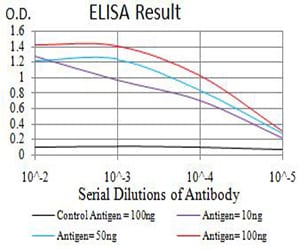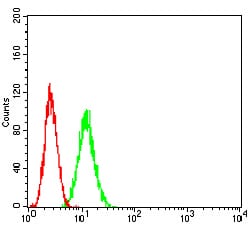


| WB | 1/500 - 1/2000 | Human,Mouse,Rat |
| IF | 咨询技术 | Human,Mouse,Rat |
| IHC | 咨询技术 | Human,Mouse,Rat |
| ICC | 技术咨询 | Human,Mouse,Rat |
| FCM | 1/200 - 1/400 | Human,Mouse,Rat |
| Elisa | 1/10000 | Human,Mouse,Rat |
| Aliases | DSH; AGS6; G1P1; IFI4; P136; ADAR1; DRADA; DSRAD; IFI-4; K88DSRBP |
| Entrez GeneID | 103 |
| clone | 4E2B5 |
| WB Predicted band size | 136kDa |
| Host/Isotype | Mouse IgG1 |
| Antibody Type | Primary antibody |
| Storage | Store at 4°C short term. Aliquot and store at -20°C long term. Avoid freeze/thaw cycles. |
| Species Reactivity | Human |
| Immunogen | Purified recombinant fragment of human ADAR (AA: 1085-1223) expressed in E. Coli. |
| Formulation | Purified antibody in PBS with 0.05% sodium azide |
+ +
以下是关于ADAR抗体的3篇参考文献及其摘要概述:
---
1. **文献名称**:*"RNA editing by ADAR1: a contributor to the dynamic epitranscriptome in human disease"*
**作者**:Herbert, A., & Rich, A.
**摘要**:该综述探讨了ADAR1介导的RNA编辑在基因表达调控中的作用,重点讨论了其在癌症和神经退行性疾病中的功能异常,并总结了ADAR抗体在检测RNA编辑活性和疾病诊断中的应用。
---
2. **文献名称**:*"ADAR1 regulates immune gene expression through RNA editing and splicing"*
**作者**:Eisenberg, E., et al.
**摘要**:研究揭示了ADAR1通过RNA编辑和选择性剪接调控免疫相关基因的机制,利用特异性抗体验证了ADAR1在自身免疫疾病(如红斑狼疮)中的异常表达及其潜在治疗靶点。
---
3. **文献名称**:*"Antibody-based detection of ADAR1 isoforms in cancer progression"*
**作者**:Zhang, X., & Xiao, W.
**摘要**:该研究开发了针对ADAR1不同亚型(p150和p110)的特异性抗体,证实ADAR1-p150在肿瘤微环境中的高表达与癌症转移相关,为基于ADAR抗体的癌症预后评估提供了实验依据。
---
如需更多文献或扩展方向(如ADAR与病毒感染的关系),可进一步补充。
ADAR (adenosine deaminases acting on RNA) antibodies are essential tools for studying RNA editing, a post-transcriptional process where adenosine (A) in RNA molecules is converted to inosine (I). This editing, catalyzed by ADAR enzymes, alters mRNA coding potential and regulates gene expression. ADARs are critical in diverse biological processes, including neural development, immune response, and cancer progression. Two primary isoforms, ADAR1 and ADAR2. exist in mammals. ADAR1. widely expressed, plays roles in innate immunity by preventing aberrant immune activation against self-RNA, while ADAR2 is predominantly active in the brain, ensuring proper neuronal function. Dysregulation of ADAR activity is linked to diseases such as Aicardi-Goutières syndrome, epilepsy, and malignancies.
ADAR antibodies enable researchers to detect and quantify ADAR protein levels, assess cellular localization (e.g., nuclear vs. cytoplasmic), and investigate functional interactions. They are used in techniques like Western blotting, immunohistochemistry, and immunoprecipitation. Specific antibodies targeting distinct ADAR epitopes or isoforms help dissect their unique roles. For instance, ADAR1-p150 (interferon-inducible) and ADAR1-p110 (constitutive) antibodies differentiate between splice variants. These antibodies also aid in exploring ADAR's involvement in viral infection responses, autoimmune disorders, and RNA-editing-targeted therapies. Validation of antibody specificity remains crucial, as cross-reactivity or off-target binding can lead to misleading conclusions. Overall, ADAR antibodies are indispensable for unraveling the complexity of RNA editing mechanisms and their pathophysiological implications.
×